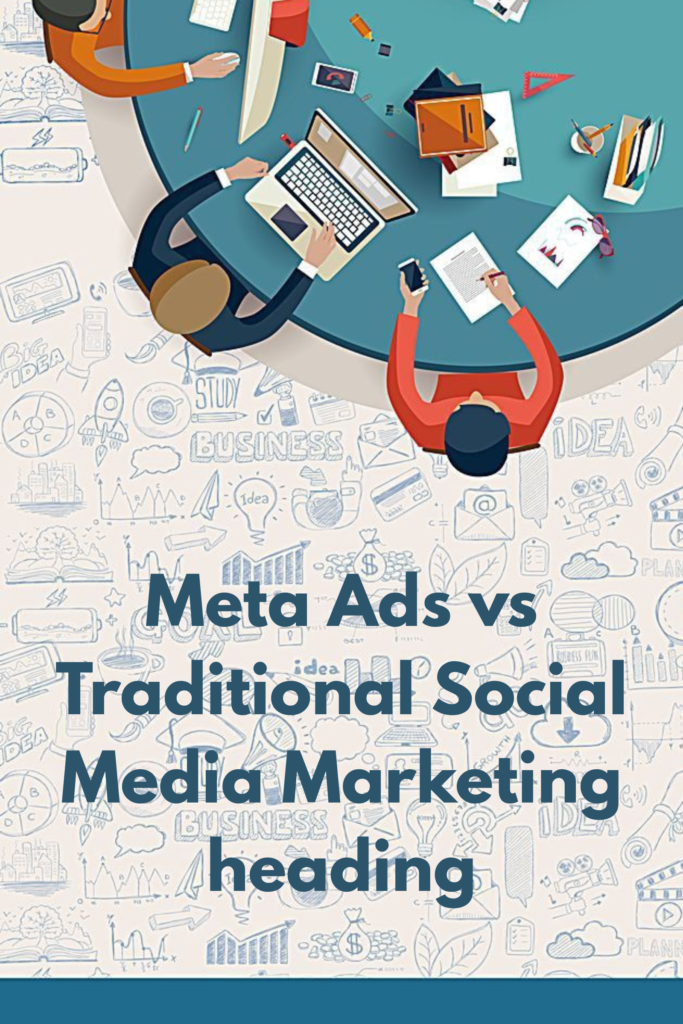Meta Ads vs Traditional Social Media Marketing
Table of Contents
In today’s digital-first world, businesses—whether startups or enterprises—must build a strong presence online. Social media platforms like Facebook and Instagram have become essential for reaching and engaging with target audiences. But with two major strategies available—Meta Ads (paid advertising) and traditional social media marketing (organic)—how do you decide which is right for your brand? This blog also discusses the benefits of social media marketing to enhance your strategy.
This blog explores both strategies in-depth, compares their advantages, including the benefits of social media marketing, and helps you determine which one is better suited for your goals.
What Are Meta Ads?
Meta Ads refer to the paid advertising options available through Meta’s platforms, including Facebook, Instagram, Messenger, and WhatsApp. These ads can be targeted based on user demographics, interests, location, behavior, and even past website activity (via Meta Pixel).
Key Features of Meta Ads:
- Paid and algorithm-driven
- Highly customizable targeting
- Multiple ad formats (image, video, carousel, stories)
- Real-time performance tracking
- Budget flexibility
What is Traditional Social Media Marketing?
Traditional (organic) social media marketing involves posting content like images, videos, stories, and reels on your social media profile to engage your audience without paying for reach. Understanding the benefits of social media marketing can help leverage this approach effectively.
Key Features of Organic Marketing:
- Free to post
- Builds brand awareness and community
- Relies on hashtags, shares, likes, and comments
- Requires consistent posting
- Grows slowly but sustainably
Meta Ads vs Organic Social Media: Side-by-Side Comparison
| Feature | Meta Ads (Paid) | Traditional Social Media (Organic) |
|---|---|---|
| Cost | Paid per click/impression | Free (except manpower/tools) |
| Reach | Fast and wide, beyond followers | Limited to followers and their network |
| Targeting | Highly specific (age, interest, location, etc.) | General, based on hashtag use and followers |
| Speed of Results | Immediate impressions and leads | Slow, builds over time |
| Trust Factor | May seem promotional | More authentic and community-driven |
| Content Longevity | Short-lived, campaign-based | Long-term presence on profile |
| Analytics & Optimization | In-depth insights for every ad | Limited to post engagement |
| Conversion Tracking | Strong with Meta Pixel | Weak unless redirected through link tracking |
When to Use Meta Ads
Meta Ads are ideal for:
- Launching a product or service and needing quick visibility
- Running time-sensitive promotions
- Retargeting website visitors who didn’t convert
- Driving leads or website traffic
- Testing ad creatives and messaging
Example:
A small clothing brand wants to boost sales for a seasonal sale. They run Meta Ads targeting women aged 18–35 interested in fashion. Within 5 days, they gain 1,000+ visits to their website and 120 sales—all tracked via Meta’s Ad Manager.
When to Rely on Organic Marketing
Organic social media works best for:
- Building community and brand loyalty
- Creating trust through storytelling
- Answering customer queries and feedback
- Sharing behind-the-scenes content
- Establishing long-term brand presence
Example:
A digital design studio consistently posts design tips, client testimonials, and portfolio updates. Over 6 months, they grow from 500 to 5,000 engaged followers—many of whom convert into paying clients via DM or referral.
Why You Shouldn’t Choose Just One
The Hybrid Strategy:
Use Meta Ads to drive traffic, generate leads, and build awareness quickly. Use organic content to nurture relationships, provide value, and keep followers engaged. Understanding the benefits of social media marketing can amplify this hybrid approach.
Think of Meta Ads as fuel, and organic marketing as the engine. One without the other limits your growth.
Best Practices for Each Approach
For Meta Ads:
- Define your objective clearly (traffic, conversions, reach)
- Use high-quality creative with strong CTAs
- A/B test ad copy and visuals
- Monitor performance daily
- Use retargeting to capture missed opportunities
For Organic Marketing:
- Post consistently (3–5 times a week)
- Use a mix of content types: images, videos, reels, stories
- Respond to comments and DMs quickly
- Use relevant hashtags and geotags
- Collaborate with influencers or brands in your niche
Which One is Better for Small Businesses?
Small businesses with a limited budget may start with organic marketing to establish a brand voice and then scale with Meta Ads for lead generation and product promotions. Meta Ads offer quicker ROI, but only if used wisely.
If you’re just starting:
- Build your organic presence first
- Learn your audience’s preferences
- Then use Meta Ads to amplify the best-performing content
Real-World Example: Café Promo Strategy
Organic Approach:
- Post a teaser reel showing the making of the coffee
- Share customer reviews and photos
- Use local hashtags (#CityCaféLovers)
Meta Ads Approach:
- Run a 7-day ad targeting people aged 18–40 in the same city
- Use mouth-watering images of the new flavor
- Offer a 20% discount for customers who show the ad at the café
Result:
Organic posts build hype and create engagement, Meta Ads drive foot traffic from new customers. Together, they create a successful campaign.
Final Verdict: Meta Ads or Organic Social Media?
There is no one-size-fits-all answer. Your ideal strategy depends on your goals, budget, and timeline.
- Choose Meta Ads if you want speed, scale, and measurable conversions.
- Choose Organic Social Media if you’re focused on brand building and long-term relationships.
- Choose Both for the best results—a short-term push with long-term growth.
Conclusion
In a competitive digital space, businesses must do more than just exist—they must be seen, heard, and remembered. Meta Ads give you the power to be seen quickly. Organic social marketing ensures you’re remembered meaningfully, highlighting the benefits of social media marketing.
Together, they’re not rivals—they’re partners in growth.

